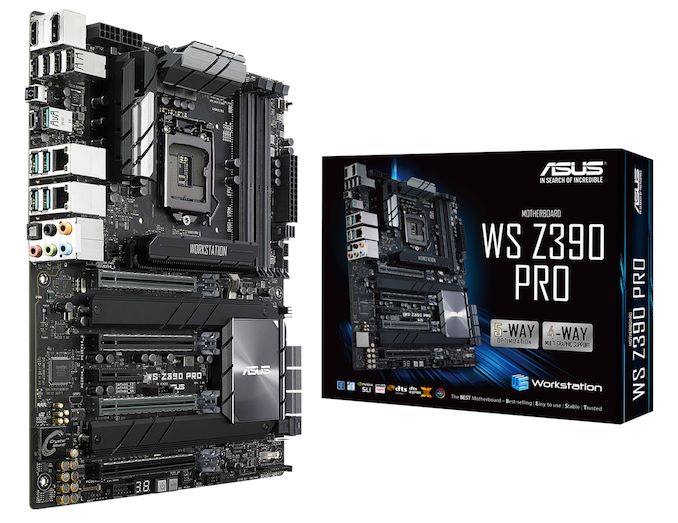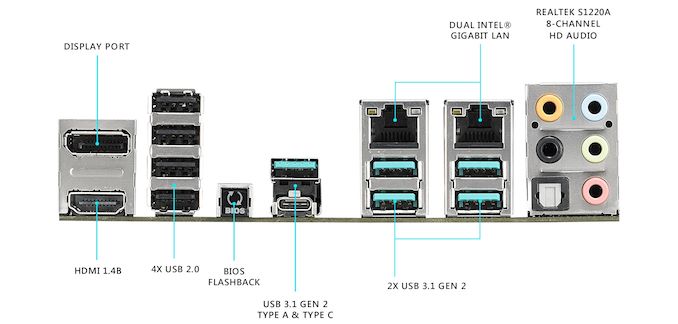Intel Z390 Motherboard Overview: 50+ Motherboards Analyzed
by Ian Cutress & Gavin Bonshor on October 8, 2018 10:53 AM EST- Posted in
- Motherboards
- Intel
- MSI
- Gigabyte
- ASRock
- EVGA
- Asus
- NZXT
- Supermicro
- Z390
ASUS WS Z390 Pro
Outside of the gaming-centric offerings on the new Z390 chipset, the ASUS WS Z390 Pro is one of the most comprehensive with a massive set of specifications and feature-rich list that makes this a very attractive high-end option. Stylistically the board has a subtle black and silver theme throughout with a glossy silver chipset heatsink. The WS stands for workstation and is designed specifically for professional users looking to build a high powered multi-core system with one of the higher end Intel Core i9- 9900K processors. The biggest feature of the WS Z390 Pro is in its ability to run up to four-way SLI thanks to four Safe Slot protected full-length PCIe 3.0 slots. The top two operate with a bandwidth of x16/x16 with two cards installed, x16/x8/x8 with three cards and x8/x8/x8/x8 with four graphics cards. Although the WS Z390 Pro has no PCIe 3.0 x1 slots to speak of, it has a single PCIe 3.0 x4 slot located between the full-length slots.
The storage options of the WS Z390 Pro includes three M.2 PCIe 3.0 slots with two of them having support for SATA drives too; also present is six SATA ports with support for RAID 0, 1, 5 and 10 arrays. The WS Z390 Pro also features two U.2 ports. The board is equipped with four RAM slots with support for DDR4-4266 and a total capacity of up to 64 GB. A total of six 4-pin PWM enabled headers are located on the board and ASUS has included two 8-pin 12 V ATX CPU power inputs for overclockers to make use of.
The WS Z390 Pro focuses less on gaming orientated features and more on professional elements with a Realtek S1200A HD audio codec powered the five 3.5 mm audio jacks and S/PDIF optical output. The rear panel also features dual Intel Gigabit LAN with an Intel I21LM and Intel I210AT Gigabit NIC. A total of ten USB ports are located on the rear panel which is split into five USB 3.1 Gen2 Type-A, one USB 3.1 Gen2 Type-C and four USB 2.0 ports. At the far left-hand side is a DisplayPort and HDMI 2.0b pair of video outputs and the WS Z390 Pro has a handily located BIOS Flashback button on the rear panel too.
As expected the WS Z390 Pro will most certainly be one of the most expensive Z390 ASUS boards at launch, with the pricing currently unknown and looks set to offer prosumers a four-way SLI capable desktop offering from one of the biggest brands in the industry. The USB 3.1 Gen2 integration in the Z390 chipset has been made to great use and the WS Z390 Pro offers the one of the most comprehensively implemented feature-sets on the entirety of the chipset. It's slightly disappointing that there's no 5 G or 10 G Aquantia LAN to be seen and this would have been a much-welcomed feature for workstation users to sink their teeth into.












79 Comments
View All Comments
gavbon - Tuesday, October 9, 2018 - link
Thank you Hickory, will update now; this information wasn't available to us at the timebill44 - Tuesday, October 9, 2018 - link
All this boards, but only 1 with Thunderbolt 3. Looks like Thunderbolt 3 is dead (free or not).Type C ports and HDMI 2.0 is in short supply too.
Hopefully next year, we can have two or more USB C (maybe even 3.2), HDMI 2.1, PCIe 4/5 and Thunderbolt 3/4 (Titan Ridge?). Or maybe not, just the same old things hoping for 2020/21.
DanNeely - Tuesday, October 9, 2018 - link
There's no licensing fee for TB, the controller chip itself still costs money (IIRC $20 or $30) and still eats 4 PCIe lanes. Worse, IIRC to make the video out feature work they need to be CPU lanes; meaning that adding it means your main GPU slot is an x8, and the secondary one only x4.gavbon - Tuesday, October 9, 2018 - link
Yeah it's a case of certain vendors opting to dismiss including TB3 ports, which only seems sensible on mini-ITX boards where PCIe lanes aren't too much of an issue. Consumer choice is important though and I'm still glad ASRock has included it; it could be a key buying decision for some!gamingkingx - Friday, October 12, 2018 - link
Just too bad it is only wired as a x2.. And it is wired into the chipset as far as I am aware, so you are gonna max out your I/Os pretty fast.bill44 - Wednesday, October 10, 2018 - link
Sure, anything you add will cost something. The are plenty of non-gamers who prefer TB3 vs x16.This also highlights how old current PC architecture is. Either we need more PCIe lanes, or faster lanes. Otherwise, all advances will be hindered.
Up to 6 USB 3.1 Gen 2 ports? You’ be lucky to get 4. Why can’t we have 6 Gen2 ports and the rest Gen1 an no antiquated USB 2.0? PCIe resources.
All new peripherals use Type C, but this boards generally give you only 1 (saving money on redrivers). USB 3.2 (20 Gbps)? When it comes around, ithis too will need more PCIe lanes. M.2. PCIe 3.0 x4? All lanes are maxed out; the only way forward is faster lanes.
In the past, Gigabyte was a TB3 champion including the functionality on many of their boards. Now, not a single one.
Cost saving by motherboard makers? Prioritising gamers? Or simply no demand for TB3.
The outcome is the same.
repoman27 - Thursday, October 18, 2018 - link
Intel merely said that they planned "to make the Thunderbolt protocol specification available to the industry under a nonexclusive, royalty-free license" sometime this year. This hasn't happened yet, and is referring to the protocol spec, not the silicon that Intel produces. If and when they decide to do this, ASMedia or whoever could then begin development of their own Thunderbolt controllers. This means that third-party controllers probably won't appear in shipping products until sometime in 2023.As for the currently available Thunderbolt 3 controllers, tray prices range from $6.45 to $9.10. But you also need a USB Type-C and PD controller, power switch, and high-speed mux which runs around $4.59, plus the connector and a few other bits. I don't believe Intel charges a royalty on finished Thunderbolt products, but they do require licensing and certification which are paid for by the OEM and may add significant cost to relatively low-volume products.
AFAIK, Windows PCs are still required to connect Thunderbolt controllers via the PCH. Apple is the only one using PEG lanes for Thunderbolt, and they don't do that on the 27-inch iMacs where it might adversely impact the GPU.
Dug - Tuesday, October 9, 2018 - link
I hope it's not dead. Far more useful than USB C. I would be fine with USB C except there doesn't seem to be a good USB C to USB C hub, which really restricts how many devices you can use. I'm really glad to see it on ASRock itx board so I can attach a portable SSD array.imaheadcase - Wednesday, October 10, 2018 - link
Tons of monitors of USB-C, anker sells USB-C hubs, I don't think i've seen thunderbolt in a desktop PC to date though. That best part of USB-C is being able to just plug phone into it and copy paste to desktop files (no Microsoft didn't invent that, it was always that way by default in windows)Valantar - Wednesday, October 10, 2018 - link
TB3 is far from dead, it just has little use in desktop PCs. Have you looked at laptop lineups recently? TB3 is _everywhere_. My workplace (a major university here in Norway) has moved entirely to TB3 docking solutions as they're the only full-featured and universal(-ish) solution.eGPUs are useless on desktops. Desktops don't need docks. USB 3.1 is plenty fast for external storage, and if you need faster storage, desktops can fit that internally. The only real use cases for TB3 on a desktop are TB3 networking (for fast direct transfers between PCs) and adding things like extra NVMe or >GbE networking on ITX boards that don't have room for that and a GPU.